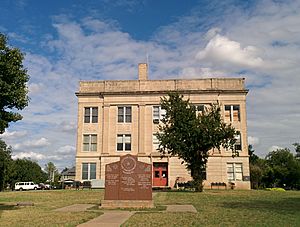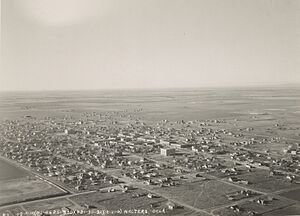Walters, Oklahoma facts for kids
Quick facts for kids
Walters, Oklahoma
|
|
|---|---|

Cotton County Courthouse in 2014
|
|
| Motto(s):
"Small town; Big heart"
|
|

Location of Walters, Oklahoma
|
|
| Country | United States |
| State | Oklahoma |
| County | Cotton |
| Area | |
| • Total | 8.33 sq mi (21.57 km2) |
| • Land | 8.07 sq mi (20.89 km2) |
| • Water | 0.26 sq mi (0.68 km2) |
| Elevation | 1,066 ft (325 m) |
| Population
(2020)
|
|
| • Total | 2,412 |
| • Density | 299.00/sq mi (115.44/km2) |
| Time zone | UTC-6 (Central (CST)) |
| • Summer (DST) | UTC-5 (CDT) |
| ZIP code |
73572
|
| Area code(s) | 580 |
| FIPS code | 40-78150 |
| GNIS feature ID | 2412177 |
Walters is a friendly town located in Cotton County, Oklahoma, in the United States. In 2020, about 2,412 people lived there. This city is special because it's the main town, or county seat, of Cotton County. It's also nestled right between two creeks. Walters has a warm motto: "Small town; Big heart."
Contents
Discovering Walters: A Look at Its Past
The land where Oklahoma is today was first home to ancient American Indian groups. These included the Clovis people around 11,500 BCE. Later came the Folsom people (10,600 BCE) and Plainview people (10,000 BCE).
Early Explorers and Native American Tribes
In the 1500s, explorers from Europe arrived. The Spanish explorer Francisco Vásquez de Coronado visited in 1541. At that time, the Wichita and Caddo tribes lived in most of the area. Around the 1700s, the Comanche and Kiowa tribes moved south from other areas. They settled in parts of Oklahoma and Texas.
Oklahoma Becomes Part of the United States
For most of the 1700s, France controlled the Oklahoma region. It was part of a large area called Louisiana. In 1803, the United States bought Louisiana from France. This was known as the Louisiana Purchase, led by President Thomas Jefferson.
Later, in 1830, the U.S. Congress passed the Indian Removal Act. This law moved many American Indian tribes from their homes. They were relocated to an area called Indian Territory. The southern part of this territory was first given to the Choctaw and Chickasaw tribes. However, in 1867, the Medicine Lodge Treaty changed things. It gave the southwest part of their land to the Comanche, Kiowa, and Apache tribes.
How Walters Got Its Name and Became a City
The city of Walters officially started on August 6, 1901. Its first name was McKnight, Indian Territory. But there was already another town named McKnight in Harmon County. So, the town needed a new name.
The name Walters was chosen to honor W. R. Walters. However, when they applied for a post office, the "s" was left off. So, the post office was named Walter.
The city grew big enough to get a government patent in June 1904. This meant it was officially recognized.
Walters Becomes the County Seat
On August 12, 1912, people voted to create a new county called Cotton County. This new county was formed from a part of Comanche County. The vote was successful, and Cotton County became the last county created in Oklahoma on August 28, 1912.
Soon after, another election was held. This time, people voted to decide if Walters or Temple would be the county seat. On December 2, 1912, Walters won by 282 votes. This made Walters the official main town of Cotton County.
For a while, people used both "Walter" and "Walters" to refer to the town. This was confusing! Finally, in June 1917, an application was made to Congress. They officially changed the post office name to Walters.
Exploring the Geography of Walters
Walters is located in the Taovayan Valley. This valley is found between the Wichita Mountains and the Red River. The area has grasslands, oak savannahs (open woodlands), and rolling hills. Walters sits on the western edge of the Cross Timbers. This is a special area where different types of land meet.
Weather and Water in Walters
Walters often gets heavy, "monsoon-like" rains in the spring. But other times of the year can have dry periods. The city is about 19 miles (31 km) south of Lawton. It is nestled between two streams that flow into the Red River. These are the East and West Cache Creeks.
The land near these creeks is full of trees. You can find Burr oak, Escarpment live oak, Shumard oak, Pecan, Eastern Redbud, American Persimmon, and American Elm trees there.
Land Area and Tourism
According to the United States Census Bureau, Walters covers about 8.4 square miles (22 km2) of land in total. Most of this, about 8.1 square miles (21 km2), is dry land. The rest, about 0.2 square miles (0.52 km2), is water.
For visitors, the Oklahoma Tourism and Recreation Department has a special name for this area. Southwestern Oklahoma, including Cotton County, is called Great Plains Country.
| Climate data for Walters, Oklahoma | |||||||||||||
|---|---|---|---|---|---|---|---|---|---|---|---|---|---|
| Month | Jan | Feb | Mar | Apr | May | Jun | Jul | Aug | Sep | Oct | Nov | Dec | Year |
| Mean daily maximum °F (°C) | 52.5 (11.4) |
58.4 (14.7) |
66.7 (19.3) |
76.2 (24.6) |
83.2 (28.4) |
91.5 (33.1) |
96.7 (35.9) |
96.7 (35.9) |
88.5 (31.4) |
77.6 (25.3) |
64.7 (18.2) |
54.8 (12.7) |
75.6 (24.2) |
| Mean daily minimum °F (°C) | 28 (−2) |
32.4 (0.2) |
39.4 (4.1) |
49.4 (9.7) |
58.7 (14.8) |
67.5 (19.7) |
71.1 (21.7) |
70.4 (21.3) |
62.9 (17.2) |
51.5 (10.8) |
39.2 (4.0) |
30.6 (−0.8) |
50.1 (10.1) |
| Average precipitation inches (mm) | 1.4 (36) |
1.6 (41) |
3.2 (81) |
3.8 (97) |
4.7 (120) |
4.8 (120) |
2.4 (61) |
2.6 (66) |
3.4 (86) |
3.3 (84) |
1.7 (43) |
1.5 (38) |
34.4 (870) |
| Source 1: weather.com | |||||||||||||
| Source 2: Weatherbase | |||||||||||||
People of Walters: A Look at Its Population
| Historical population | |||
|---|---|---|---|
| Census | Pop. | %± | |
| 1910 | 1,377 | — | |
| 1920 | 3,032 | 120.2% | |
| 1930 | 2,262 | −25.4% | |
| 1940 | 2,238 | −1.1% | |
| 1950 | 2,743 | 22.6% | |
| 1960 | 2,825 | 3.0% | |
| 1970 | 2,611 | −7.6% | |
| 1980 | 2,778 | 6.4% | |
| 1990 | 2,519 | −9.3% | |
| 2000 | 2,657 | 5.5% | |
| 2010 | 2,551 | −4.0% | |
| 2020 | 2,412 | −5.4% | |
| U.S. Decennial Census | |||
In 2000, there were 2,657 people living in Walters. These people made up 1,063 households and 721 families. The city had about 327 people per square mile.
Diversity in Walters
The people in Walters come from many different backgrounds. In 2000, the population was:
- 84.38% White
- 0.38% African American
- 10.24% Native American
- 0.08% Asian
- 1.02% from other races
- 3.91% from two or more races
Also, 3.42% of the population identified as Hispanic or Latino.
Households and Age Groups
Out of all the households, 33.6% had children under 18 living there. About 54.1% were married couples living together. Also, 10.4% had a female head of household with no husband present.
The age of people in Walters varied:
- 27.8% were under 18 years old.
- 7.4% were between 18 and 24.
- 26.7% were between 25 and 44.
- 19.9% were between 45 and 64.
- 18.3% were 65 years or older.
The average age in the city was 37 years.
Historic Buildings in Walters
Walters is home to several important historic buildings. These buildings are listed on the National Register of Historic Places. This means they are recognized for their special history and architecture.
- The First United Methodist Church: This beautiful church was built in 1917.
- The Cotton County Courthouse: This building was constructed in 1925. It has a Classical Revival style, which means it looks like ancient Greek and Roman buildings.
- The Walters Rock Island Depot: This used to be a train station. In 1984, the city bought it. The Cotton County Art Council then fixed it up. Now, it's a museum where you can learn about the area's history.
Culture and Community in Walters
Walters has a strong community spirit and a rich culture.
Local News
The Walters Herald is the local newspaper. It has been published since 1925. It calls itself "The Voice of Cotton County," sharing news and stories from the area.
Fun Festivals in Walters
Walters hosts many exciting festivals throughout the year. These events celebrate different parts of the community. They focus on art, farming, Cowboy culture, and Native American traditions.
Spring Celebrations
- The CCAC Arts & Crafts Festival: This festival showcases local artists and crafters. It's sponsored by the Cotton County Art Council and the Oklahoma Arts Council.
Summer Events
- Comanche Nation Homecoming Powwow: This is a vibrant celebration of Native American culture. It features many types of traditional American Indian dancing. You can see gourd, cloth, buckskin, straight, and fancy dances. There are also food and merchandise vendors.
- Round Up Club Rodeo: This multi-day rodeo event is full of action. Besides the rodeo itself, there's a parade. The parade features decorated cars, trucks, tractors, and floats.
Famous People from Walters
Many notable individuals have connections to Walters:
- Terry_Brown_(American_football): He is the only Oklahoman to score a touchdown in a Super Bowl.
- Fred R. Harris (born 1930): A former U.S. Senator from Oklahoma. He also ran for U.S. president.
- LaDonna Harris (born 1931): A Comanche Native American social activist and politician.
- Van Heflin (1908-1971): A famous Hollywood movie actor.
- Jed Johnson Sr. (1888-1963): A politician and editor who practiced law in Walters.
- Abe Lemons (1922-2002): A well-known college basketball coach who graduated from Walters High School.
- James C. Nance: A publisher of community newspapers in Oklahoma. He also served as Speaker of the Oklahoma House of Representatives and President pro tempore of the Oklahoma Senate.
Services in Walters
Hilliary Communications provides important services to the community. They offer telephone, Internet, and Digital TV services.
See also
 In Spanish: Walters (Oklahoma) para niños
In Spanish: Walters (Oklahoma) para niños


